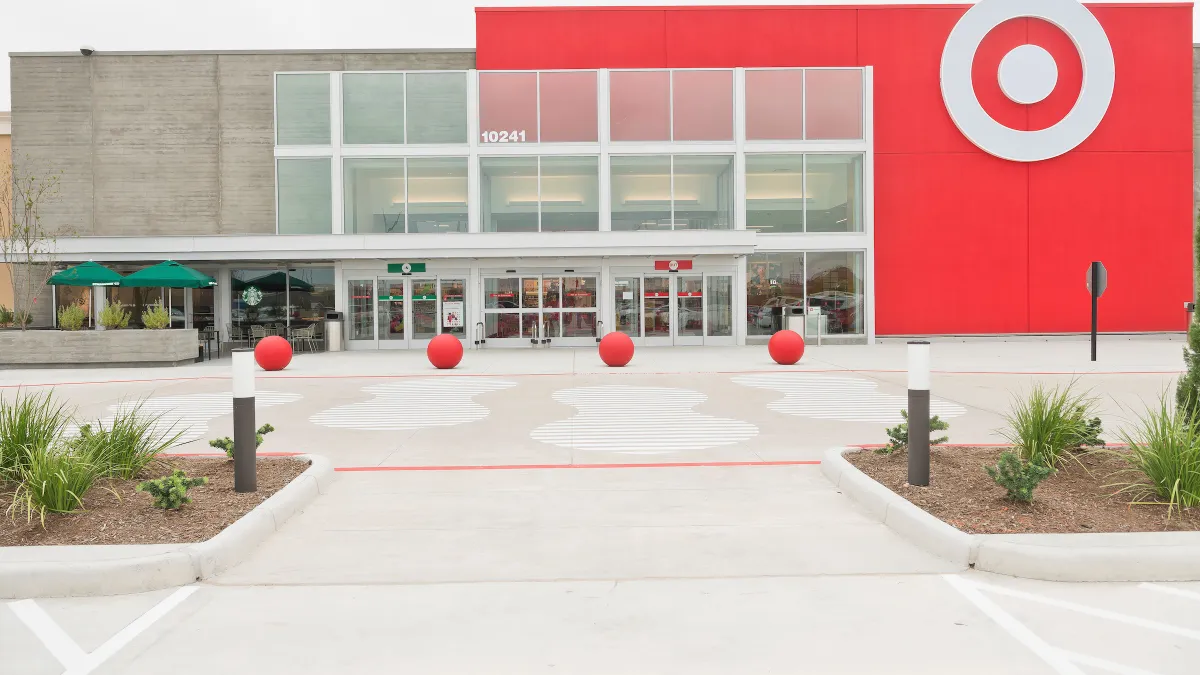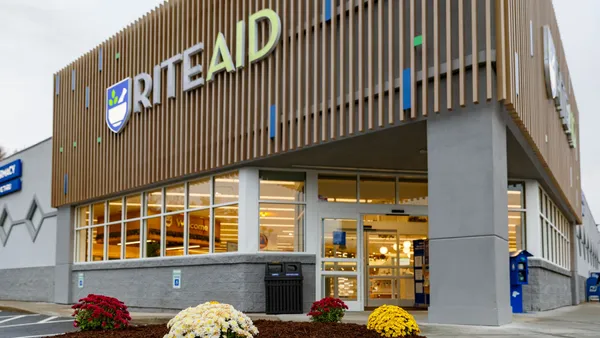Dive Brief:
-
Target on Wednesday reported that third quarter sales rose 1.4% to $16.7 billion from $16.4 billion last year, besting the Zacks consensus estimate of $16.6 billion. Target expects fourth-quarter same-store sales growth of flat to 2% and full-year same-store sales growth of flat to 1%.
-
Same-store sales in the quarter rose 0.9% as traffic rose 1.4%, according to a company press release. E-commerce same-store sales rose 24%, a bit lower than the 26% rise a year ago, the company said. The company spent $847 million on capital investment.
-
The retailer’s gross margin rate in the quarter was 29.7%, up from 29.8% a year ago, reflecting pressure from e-commerce fulfillment costs and pricing and promotion efforts, offset somewhat by cost savings, according to a press release. Net income fell to $480 million, or 88 cents per share, down from $608 million, or $1.06 per share, in the third quarter last year. Adjusted earnings from continuing operations fell 13.1% from the year-ago quarter to 91 cents per share, though that bested the Zacks consensus estimate for 86 cents per share.
Dive Insight:
Target is investing in the long term, and it stings. Notably though, its effort to provide differentiated merchandise is helping.
"[Third quarter] results for Target reflect the impact of its short-term investments for long-term benefit, with margins softening slightly as a result of Target’s tactical price investments, as well as the persistent market share battles with Amazon and Walmart in multiple categories, though we believe margin erosion is being mitigated to an extent by private and exclusive brands, which are resonating with shoppers," noted Moody’s Investors Service Lead Retail Analyst Charlie O’Shea in an email to Retail Dive.
The retailer’s capital improvements are "meaningful," according to O’Shea, "resulting in cash up over $1.5 billion year-over-year, and 24% online growth continues to place Target in the upper echelon of brick-and-mortar retailers from a percentage growth perspective. [A]ll-in-all, we believe Target is executing its strategic plan effectively."
But it’s taking an awfully long time and has been expensive, warned GlobalData Retail Managing Director Neil Saunders, citing its slim 0.9% same-store sales growth and noting that both operating profit and net income are down sharply from last year. "All of this raises two questions. Is Target on the right track? And, is the effort and expense of the company's turnaround worth the potential reward?" Saunders said in a note emailed to Retail Dive. "We believe that the answer to both queries is yes, albeit with some reservations."
Increased staffing, price cuts and the retailer’s store improvements have taken a chunk of money, but they should be perceived as investments more than costs, Saunders suggested. "Without them, we believe Target's future would be bleak," he said.
GlobalData Retail’s analysis on Target's reinvention process, which has included visits to new and refurbished stores, a look at sales patterns, surveys of its shoppers and talking to staff has led analysts to conclude that "Target is making the right moves."
Target is creating a more open format with improved visual merchandising and a more logical layout, with upgrades to decor, fixtures, lighting and signage, GlobalData Retail analysts note. "A store like Talking Stick in Arizona has gone from being a dingy, down-at-heel shopping experience to an attractive, modern space which is pleasant and comfortable to shop," Saunders said, saying that customers have noticed, are pleased and are shopping there more.
Still, the pace is slow. "Our initial data indicate that metrics like frequency of shop, amount of time spent in the store, and average basket size are all rising," he said. "However, they are doing so at a gradual pace, which suggests to us that the return on the improvement expense will only accrue over time. This is one of the reasons why store-only comparables increased by a meager 0.1%, with the rest of the increase coming from the digital operation."
"These investments are for the long term," said CEO Brian Cornell during a call with media following the earnings release, referring to investments across the board in brands, digital capabilities, fulfillment and stores "The most important element for me is the full year EPS outlook and the fact that we're improving that outlook by 50 cents and generating $500 million of additional upside."
Target is aggressively developing and rolling out new brands and partnerships, but could be more aggressive when it comes to presentation. The new Project 62 home collection, for example, is a strong play but isn’t presented well in stores, said Saunders. "It is almost as if Target lacks the confidence to push this range heavily. Target needs to be bolder with these new brand assets if it is to attract more customers and improve sales."
Grocery sales continue to be a weak spot. Cornell has said the retailer doesn’t aim to be a traditional grocery store, but its assertive pricing play, while helpful to some degree, isn’t enough to drive these all-important sales, according to Saunders, who suggested that the retailer needs to bring its differentiation chops to this segment. "Target lacks a comprehensive food strategy," he warned. "This part of the operation will not see significant traction until Target comes up with much clearer points of differentiation — something that still appears to be a long way off."
Simply put, Target "needs to be bolder and more creative" and solve some retail fundamentals like stocking and shelving issues. Still, Saunders shrugged off the concerns evident in investors pull-back Wednesday morning. "The company is now in a much stronger position than it was at this time last year, which bodes well for the holiday quarter and beyond," he said.
This story is part of our ongoing coverage of the 2017 holiday shopping season. You can browse our holiday page and sign up for our holiday newsletter for more stories.















